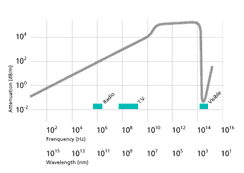
All eyes are sensitive to a common, rather narrow range of wavelengths within the broad spectrum of energy produced by the sun. Why is this? Why can't we see more of this spectrum? The most likely explanation is that eyes first evolved in animals living in water, and, water, due to its fundamental nature, filters out all but two quite narrow ranges of electromagnetic (EM) radiation [1, 2]. As shown in figure 1, the range of EM radiation 'visible' for most organisms is a narrow, sharply defined band, ranging from the very short wavelengths we think of as having a blue color to longer wavelengths we identify as red. It is particularly narrow when compared with the full range of EM radiation produced by the sun. In our language, we divide this narrow range of perceived wavelengths into seven names (red, orange, yellow, green, blue, indigo, violet), also called spectral colors. As is clear from the figure, in this very narrow band, EM radiation penetrates water better than the adjacent wavelengths by about 6 orders of magnitude. So, since our ultimate ancestors existed in a watery slime, the only radiation to penetrate water must have been the primary selective force. As we see now, this early selection for the narrow spectrum ultimately drove the evolution of biochemical mechanisms sensitive to these colors of light. This is true both for perception of light by animals and for photosynthesis by plants. Now, five billion years later, though many animal species have moved onto land where the sun's full spectrum is available, eyes remain sensitive only to this narrow region. That limit comes now, not from the filtering properties of water but rather from the biochemical mechanisms that evolved in response to the limited wavelengths penetrating the original slime. Once selection started organisms down that path, mechanisms that evolved limited future options.
It is true that many insect species as well as some species of fish and birds can 'see' in the ultraviolet, or very short wavelength end of the visible spectrum. However, they do so with slight modifications of the same biochemical system that the rest of us use to see, not with new mechanisms. This particular exploitation is remarkable because the energy in photons at the short wavelengths is very high.
As seen in figure 1, EM radiation penetrates water quite well at the very low frequency end of the spectrum (<103 Hz) explaining why it is dangerous to put power wires into water, among other things. This range of wavelengths is actually used by some organisms to gather sensory information. For example, weakly electric fish evolved independently in both Africa and South America, and species from both groups use low frequencies to signal conspecifics about reproduction and other important things in murky water where normal vision is not much use.
The Evolution of Eyes
Why Do We See What We See?
How Do Eyes Work and How Did They Evolve?
How Do Eyes Capture Photons?
Where Do Lenses Come From?
Eyes: Convergence or Homology?
Conclusions
References
Biography
>> next
